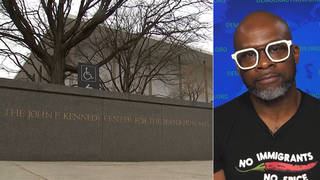
Saturday marked the anniversary of the U.S. Supreme Court’s Dobbs decision that saw the conservative majority overturn Roe v. Wade and end the federal right to abortion. Abortion rights activists rallied in Washington, D.C., and elsewhere across the country to demand access to reproductive healthcare. In the year since the ruling, more than a dozen states have passed new abortion bans, and about 25 million women of childbearing age now live under tighter restrictions than before the court intervened. However, thanks to grassroots organizing efforts and underground abortion networks, “Abortions are still happening in every state in the country every day,” says Amy Littlefield, abortion access correspondent for The Nation. Littlefield discusses how abortion activists are working to continue providing care, as well as what to expect from the anti-abortion movement as it seeks to further restrict reproductive rights.
Transcript
AMY GOODMAN: This is Democracy Now!, democracynow.org, The War and Peace Report. I’m Amy Goodman.
Hundreds of abortion rights supporters rallied in Washington, D.C., over the weekend to mark the first anniversary of the Supreme Court’s overturning of abortion rights. This is one of the protesters, Nadine Seiler.
NADINE SEILER: We need to be engaged. If we don’t show up and if we don’t participate, we get what we get. And what we get is our rights taken away.
AMY GOODMAN: The protests came as anti-choice activists also rallied in D.C. This is Republican presidential hopeful, former Vice President Mike Pence speaking to a gathering of conservatives, who were talking about the decision by the Supreme Court to overturn Roe v. Wade as a historic victory, he said, but he said it didn’t go far enough, and called for a nationwide 15-week ban on abortion.
MIKE PENCE: Because of your work and because of your prayers, the Supreme Court of the United States sent Roe v. Wade to the ash heap of history, where it belongs, and gave America a new beginning for life.
AMY GOODMAN: We’re joined now by Amy Littlefield, abortion access correspondent for The Nation. She was in D.C. this weekend at both the protests and has apiece in the special issue of The Nation called the “Body Politics,” her piece, “'The Message They've Received Is That You Don’t Deserve to Be Cared For’: Life on the Abortion Borderland.”
Amy, welcome back to Democracy Now! Lay out what happened this weekend, and then talk in a larger way about what’s happening around abortion in this country, at a point where abortion is being banned in so many states, and yet the support for abortion is skyrocketing.
AMY LITTLEFIELD: Thanks so much, Amy. It’s great to be back with you.
I started out my weekend on Friday at the National Right to Life Convention, a gathering of the nation’s oldest anti-abortion organization. And you might expect that a year after the Dobbs decision overturned Roe v. Wade, the anti-abortion movement would be celebrating, right? But that’s not the case. And that’s because anti-abortion leaders are coming to terms with two realities that are very unfortunate to them. And the first is that abortion bans, that they have dreamed of instituting for decades, that are now in place in 13 states, mostly concentrated in the South, are not working the way that they hoped they would, and they’re also deeply unpopular. And so, we’ve seen six ballot initiatives in the year after Dobbs; one pivotal Wisconsin state Supreme Court race; we’ve seen, you know, the red wave expected in the midterms that never was — all because of the outrage over the Dobbs decision.
And then we’ve seen the latest numbers coming out from the Society for Family Planning that show in the nine months after the Dobbs decision, the number of abortions dropped by 25,000. Now, that’s the abortions that are being recorded. That is a catastrophically high number, because every person denied an abortion that they want is a human rights tragedy. But for abortion rights opponents, who have dreamed of instituting these bans for a generation, that is way lower than the number they expected. They were hoping it would be in the hundreds of thousands.
And so, they’ve realized that their bans are not working, that as the headline — We Testify and I Need an A put out a fake newspaper over the weekend to mark the Dobbs anniversary, and the headline said, “We Are Still Having Abortions All Across the Country.” And that is true. So, abortions — because of the robust grassroots infrastructure and clinicians who are going to heroic lengths to get people access to the care they need, abortions are still happening in every state in the country every day. And people familiar with the informal pill circulation networks have told me that there is more than enough medication abortion coming into the country and being circulated through these mutual aid networks to compensate for those 25,000 abortions that were not recorded in the nine months after Dobbs.
So, what we’re going to see, I think, in the coming months, Amy, from the anti-abortion movement are efforts to contend with the fact that the public doesn’t like their bans and with the fact that the bans are not actually working. And so, what I saw at the National Right to Life Convention is leaders like James Bopp, who, in addition to, you know, being longtime general counsel of National Right to Life, is also the architect of Citizens United, telling state affiliates that they need to institute much broader, more sweeping enforcement mechanisms, like using RICO laws, that were used to take down the mob, using anti-trafficking laws to make it harder to travel out of state, and, to sweeten the deal for state lawmakers, sugarcoat those enforcement restrictions by using rape and incest exceptions, as if that — you know, that’s going to be the red herring that we see to try to get much more extreme enforcement provisions to try to make these bans that aren’t working work better.
And then, number two, we’re going to see this PR campaign. Abortion bans are no longer to be called “bans,” because the anti-abortion movement has realized that the word “ban” makes their policies less popular, even though that’s precisely what these measures are. So we’re going to see them being called “protections” or “limits.” We’re not going to see “crisis pregnancy center” as much anymore, because there’s now a lot of robust information about how deceptive these anti-abortion centers are on the internet, and so they’re rebranding them as “pregnancy resource centers” instead.
So, there’s a marketing campaign going on here to try to make their abortion bans more popular at a time when a vast majority of Americans disagree with the overturning of Roe v. Wade, and also to institute much more sweeping enforcement mechanisms.
AMY GOODMAN: Uh —
AMY LITTLEFIELD: Now, that’s from the wing of the movement — yeah, go ahead, Amy.
AMY GOODMAN: No, go ahead, Amy. Keep going.
AMY LITTLEFIELD: So, the next day, Saturday, I went to Washington, D.C. And, you know, it’s important to state, the National Right to Life Convention seems to be the wing of the movement that cares about public opinion. Right? They care about the fact that they’ve, you know, kind of subverted democracy by instituting these unpopular bans, and they’re trying to figure out some workarounds there.
In Washington, D.C., I saw — I went to a rally hosted by Students for Life. That was the rally where Mike Pence spoke. They invited all of the leading GOP candidates, or all of the GOP candidates, and Pence was the one who accepted the invitation. He’s vying to be the candidate of the movement. They were rolling out, I will say, a much more overt plan. It’s not a more extreme plan, because, of course, the end goal of the anti-abortion movement across the board is protections for the embryo starting at the moment of fertilization — aka a ban, OK? Let’s call it what it is. They are calling for using the 14th Amendment to apply due process and equal protection to the embryo from the moment of fertilization. And, in fact, Lila Rose of the anti-abortion group Live Action said on the steps of the Lincoln Memorial that she believes that this protection is already in place, that laws in states like New York that protect access to abortion are in violation of the 14th Amendment.
So, what we’re seeing here is an attempt to wrap their heads around the fact that they’re not going to be able to pass new restrictions on abortion in this moment, when abortion rights are at — are historically popular. And so, what they’re trying to do is use existing laws that are on the books, and get courts, or perhaps the next Republican president, to buy into this idea that the 14th Amendment protects embryos from the moment of fertilization. Now, the impacts of that, of course, would be kind of unfathomable.
AMY GOODMAN: Let me ask you about a piece in The Intercept that has the headline “The FBI Is Hunting a New Domestic Terror Threat: Abortion Rights Activists.” Can you explain what’s going on at the national level? I mean, clearly, President Biden, Vice President Harris out on the first anniversary of the overturning of Roe, supporting abortion rights. What’s going on here?
AMY LITTLEFIELD: Right. So, I mean, there’s a federal law called the FACE Act that was put into effect in the 1990s because anti-abortion militants were barricading abortion clinics, chaining themselves to cars, using militant nonviolent civil disobedience tactics to shut abortion access down. It’s been very sparsely enforced against anti-abortion groups over the years. And what we’re seeing now is that that law is actually being used to target groups like Jane’s Revenge, that are doing things like spray-painting crisis pregnancy centers. So, you know, The Intercept has done some great reporting on the consequences of, I think, the Biden administration feeling pressure to go after abortion rights groups. And certainly, there is a sense from the anti-abortion movement that they are under attack, that they’re getting threats, that groups like Jane’s Revenge are targeting crisis pregnancy centers and are — you know, that there’s a sort of more militant, and then also in less militant ways, that the public is showing their opposition to these policies.
But, you know, I want to emphasize here, I think this is part of a concerted effort by the anti-abortion movement to frame their opposition, to frame abortion rights supporters, as extreme, rather than being in the majority. And, you know, I think the real extremism that was on display was at this Students for Life rally in Washington, D.C., where, for example, there was a man standing at the back of the rally holding a huge billboard-sized sign that said, “You can’t end abortion if women can still get away with murder.” Now, this is related to the —
AMY GOODMAN: Ten seconds.
AMY LITTLEFIELD: — abortion abolition movement, to a group that’s gaining power by saying you need to criminalize women and put them in jail for abortions. This is the fringe now, but we’ve seen over time that in the anti-abortion movement, the fringe has become the center. So, I would keep an eye on these growing efforts to punish people who have abortions and who self-manage their abortions.
AMY GOODMAN: Amy Littlefield —
AMY LITTLEFIELD: And you can go to PlanCPills.org —
AMY GOODMAN: — abortion access correspondent at The Nation. Amy, we’re going to continue the conversation after and post it at democracynow.org. Happy birthday to Karen Ranucci! I’m Amy Goodman.











Media Options